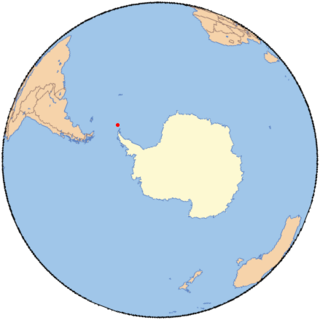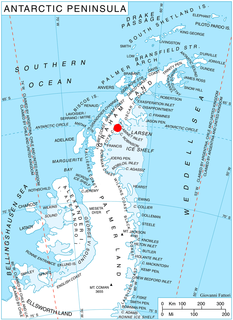Simmons Glacier is a glacier draining northward between Mount Isherwood and Mount Strange in the east part of the Kohler Range, Marie Byrd Land. Mapped by United States Geological Survey (USGS) from surveys and U.S. Navy air photos, 1959-66. Named by Advisory Committee on Antarctic Names (US-ACAN) for Harry S. Simmons, assistant to the United States Antarctic Research Program (USARP) Representative in Christchurch, New Zealand, for four seasons, 1969-70 through 1972-73. His duties took him to Antarctica in 1971 and 1973.

Lawrie Glacier is a glacier flowing between Mount Genecand and Mezzo Buttress, and entering the head of Barilari Bay between Cherkovna Point and Prestoy Point on the west coast of Graham Land, Antarctica. It was charted by the British Graham Land Expedition under Rymill, 1934–37, and was named by the UK Antarctic Place-Names Committee in 1959 for Robert Lawrie, an English alpine and polar equipment specialist.
Barrett Buttress is a nunatak rising to 1,600 metres (5,250 ft) at the south margin of Goodenough Glacier, 9 nautical miles (17 km) southwest of the Blanchard Nunataks in western Palmer Land. The feature has a sheer northwest face 150 metres (500 ft) high; the southeast side is level with the snow plateau. It was mapped by the United States Geological Survey from U.S. Navy aerial photographs taken 1966–69, and was named by the UK Antarctic Place-Names Committee in 1977 after Richard G. Barrett, a British Antarctic Survey surveyor at Stonington Island and Adelaide Island stations, 1974–76.
Bedford Island is an island about 1 nautical mile (2 km) long, lying at the south end of the Barcroft Islands in the Biscoe Islands. It was mapped from air photos taken by the Falkland Islands and Dependencies Aerial Survey Expedition (1956–57), and named by the UK Antarctic Place-Names Committee for Thomas Bedford, an English physicist who specialized in the measurement of the physical environment of man.

Borradaile Island is one of the Balleny Islands. It was the site of the first landing south of the Antarctic Circle, and features the "remarkable pinnacle" called Beale Pinnacle, near Cape Beale on its south-eastern coast, and Cape Scoresby on its north-western coast.
Mount Bushnell is a mountain, 840 metres (2,760 ft) high, between Mount Durham and Pincer Point in the northwest part of the Tapley Mountains. It was first roughly mapped by the Byrd Antarctic Expedition, 1928–30, and remapped by the United States Geological Survey, 1960–64. It was named by the Advisory Committee on Antarctic Names for Vivian C. Bushnell of the American Geographical Society, editor of the Society's Antarctic Map Folio Series.
Tutton Point is the southwestern point of Liard Island in Hanusse Bay, Graham Land. This point is a landing place, the start of a route into the interior of the island. Mapped from air photos taken by Ronne Antarctic Research Expedition (RARE) (1947–48) and Falkland Islands and Dependencies Aerial Survey Expedition (FIDASE) (1956–57). Named by United Kingdom Antarctic Place-Names Committee (UK-APC) for Alfred E.H. Tutton (1864–1938), British mineralogist, author of The Natural History of Ice and Snow Illustrated from the Alps.
The Gunn Peaks are isolated peaks 9 nautical miles (17 km) east of Mount Vang in southern Palmer Land, Antarctica. They were mapped by the United States Geological Survey from ground surveys and U.S. Navy air photos, 1961–67, and were named by the Advisory Committee on Antarctic Names for Robert C. Gunn, a glaciologist at Byrd Station, summer 1965–66.

Gourlay Peninsula is an ice-free peninsula, which is 0.1 nautical miles (0.2 km) wide at its base and widens to 0.4 nautical miles (0.7 km), forming the southeastern extremity of Signy Island in the South Orkney Islands. The seaward end of the peninsula divides into three arms, Pantomime Point, Pageant Point, and Gourlay Point. It was surveyed in 1933 by Discovery Investigations personnel, and resurveyed in 1947 by the Falkland Islands Dependencies Survey. It was named by the UK Antarctic Place-Names Committee after Gourlay Point.
Gourlay Point is the southernmost of three finger-like points which form the southeast end of Signy Island, in the South Orkney Islands. It was charted in 1933 by Discovery Investigations personnel on the Discovery II, who gave the name for Ronald George Gourlay, third engineer of the ship.

Perutz Glacier is a glacier, 10 nautical miles (18 km) long and 2 nautical miles (3.7 km) wide, which flows west-northwest from Hemimont Plateau into Bourgeois Fjord, close east of Thomson Head, on the west coast of Graham Land, Antarctica. The mouth of the glacier was first surveyed in 1936 by the British Graham Land Expedition (BGLE) under Rymill. The entire glacier was surveyed in 1946-47 and 1948-49 by the Falkland Islands Dependencies Survey (FIDS), and named by them for Max F. Perutz of the Cavendish Laboratory, Cambridge, who has made important studies on the mechanism of glacier flow.
Friederichsen Glacier is a glacier 7 nautical miles (13 km) long, which flows in an easterly direction into Cabinet Inlet, close north of Mount Hulth, on the east coast of Graham Land, Antarctica. It was charted by the Falkland Islands Dependencies Survey (FIDS) and photographed from the air by the Ronne Antarctic Research Expedition in 1947. It was named by the FIDS for Ludwig Friederichsen, a German cartographer who in 1895 published a chart based upon all existing explorations of the Antarctic Peninsula and the South Shetland Islands.

Livonia Rock is a rock lying 0.5 nautical miles (1 km) south of Cape Melville, the eastern extremity of King George Island, in the South Shetland Islands, Antarctica. It was named by the UK Antarctic Place-Names Committee in 1960 for the sealing vessel Livonia from London, which visited the South Shetland Islands in 1821–22.
Megaw Island is the easternmost of the Bennett Islands in Hanusse Bay, Antarctica. It was mapped from air photos taken by the Ronne Antarctic Research Expedition (1947–48) and the Falkland Islands and Dependencies Aerial Survey Expedition (1956–57). The island was named by the UK Antarctic Place-Names Committee for British physicist Helen Megaw, who in 1934 made accurate measurements of the cell dimensions of ice.
Herrington Hill is a hill on the east side of Lavoisier Island, in the Biscoe Islands of Antarctica, about 5 nautical miles (9 km) southward of Benedict Point. It was mapped from air photos taken by the Falkland Islands and Dependencies Aerial Survey Expedition (1956–57), and was named by the UK Antarctic Place-Names Committee for Lovic P. Herrington, an American physiologist who has specialized in the reactions of the human body to cold environments.
Mazza Point is a snow-covered headland lying between Brahms Inlet and Mendelssohn Inlet, marking the northwest end of Derocher Peninsula, a minor peninsula that extends in a northwest point from Beethoven Peninsula, situated in the southwest portion of Alexander Island, Antarctica. The headland was first mapped by the United States Geological Survey from U.S. Navy aerial photographs taken in 1967–68 and from U.S. Landsat imagery taken in 1972–73. It was named by the Advisory Committee on Antarctic Names for Commander Joseph D. Mazza, U.S. Navy, Commanding Officer of Squadron VXE-6, May 1986 to May 1987.

Spur Point is a point at the east end of Bigla Ridge, a black, rocky spur which extends southeast between Sleipnir Glacier and Beaglehole Glacier to the west side of Cabinet Inlet, forming the southeast extremity of Heros Peninsula on the east coast of Graham Land. This descriptive name was given by the Falkland Islands Dependencies Survey (FIDS) following their survey in 1947. The feature was photographed from the air during 1947 by the Ronne Antarctic Research Expedition (RARE) under Ronne.

Holdfast Point is both the northeast side of the entrance to Lallemand Fjord and the northwest side of the entrance to Chepra Cove on Pernik Peninsula in Graham Land, Antarctica, situated about 12 nautical miles (22 km) southwest of Cape Rey. It was mapped from air photos taken by the Falkland Islands and Dependencies Aerial Survey Expedition (1956–57), and was so named because when the pack ice breaks out to the north of Lallemand Fjord, it usually continues to hold fast for some time longer south of this point.

Hopkins Glacier is a glacier situated south of Erskine Glacier and flowing westwards into the head of Tlachene Cove in Darbel Bay on the west coast of Graham Land, Antarctica. It was photographed by Hunting Aerosurveys Ltd in 1955–57, and mapped from these photos by the Falkland Islands Dependencies Survey. It was named by the UK Antarctic Place-Names Committee in 1958 for Sir Frederick Hopkins, founder of the School of Biochemistry at Cambridge University, who made pioneer investigations on synthetic diets and vitamins which contributed greatly to the development of present ideas on concentrated rations.











